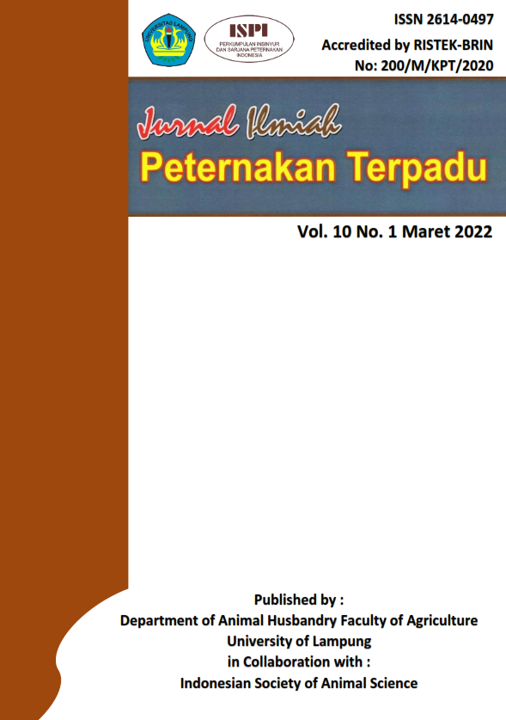The Chemical, Microbiological, and Sensory Characteristics of Cangkuk: a Fermented Beef Meat from Kuantan Singingi, Riau Province
DOI:
https://doi.org/10.23960/jipt.v10i1.p1-17 Abstract View: 742
Abstract View: 742
Keywords:
Beef meat fermentation Cangkuk Chemical Characteristic Kepayang seed (Pangium edule Reinw) Traditional foodAbstract
Traditional fermented meat products made from the flesh food in Indonesia are still rare, one of which is interesting to study is cangkuk. This research was conducted to study of the details cangkuk processing, the chemical, microbiological, and sensory characteristics of cangkuk originating Kuantan Singingi. The research consists of two stages (1) surveys and interviews regarding raw materials, formulations, processing methods and sociology of cangkuk, (2) analysis of their chemical, microbiological and sensory characteristics. Sampling method of the cangkuk by purposive sampling, derived from four villages : Sungai Manau, Kinali, Inuman and Pangean. Data analysis was done descriptively. The result showed that the processing of cangkuk had three formulations according to ratio between meat: bamboo shoots and or kepayang seeds:(2:1);(1:1);(1:1,7). Fermentation progress in anaerobic condition for seven days. The chemical characteristics were as follows: the content of water, protein, lipid, ash and pH value were 68-71%, 18-19%, 1,8-2,3%, 1,2-1,6%, 3,6-5,2, respectively. The total lactic acid bacteria (LAB) were 103-108 cfu/g, negative Salmonella, and total E.coli was <3-9,4 mpn/g. The sensory characteristic showed typical of color, sting aroma and meat texture was slightly tender. It can be concluded that the processing of cangkuk from Kuantan Singingi identified by ratio of raw materials and variety of fermentation media, good in chemical characteristic and total LAB, had typical sensory characteristic, but still contaminated E. Coli.Downloads
References
Al-mentafji, H.N. 2006. Official Methods of Analysis of AOAC INTERNATIONAL. AOAC International. Maryland
Aldona, R., Y. L. Anggrayni, and D. Kurnia. 2019. Uji organoleptik terhadap daging sapi bali fermentasi (cangkuk) dengan lama penyimpanan yang berbeda. Journal of Animal Center 1(2): 56–72.
Anal, A.K. 2019. Quality ingredients and safety concerns for traditional fermented foods and beverages from Asia: A review. Fermentation 5(1). DOI: 10.3390/fermentation5010008
BSN. 1992. SNI 01.2891:1992 Cara Uji Makanan dan Minuman. Bsn 1992: 1–39.
Dimidi, E., S. Cox, M. Rossi, and K. Whelan. 2019. Fermented Foods : Definitions and Characteristics , Gastrointestinal Health and Disease. Nutrients 11(1806): 1–26.
Mamuaja, C. F., and L. Helvriana. 2017. Karakteristik Pasta Tomat dengan Penambahan Asam Sitrat Selama Penyimpanan. Jurnal Ilmu dan Teknologi Pangan 5(1): 17–23.
Ockerman, H. W., and L. Basu. 2008. Handbook of Fermented Meat and Poultry. DOI: DOI:10.1002/9780470376430.ch2
Putra, I.K. 2009. Efektifitas Berbagai Cara Pemasakan Terhadap Penurunan Kandungan Asam Sianida Berbagai Jenis Rebung Bambu. Agrotekno 15(2): 40–42.
Salahuddin. 2004. Kajian Fermentasi Cangkuk dari Daging Sapi dan Rebung Bambu Betung (Dendrocalamus asper). Sekolah Pascasarjana. Institut Pertanian Bogor.
Sari, R dan Suhartati. 2015. PANGI (Pangium edule REINW.) sebagai tanaman serbaguna dan sumber pangan. Buletin Eboni 12(1): 23–37.
Setyaningsih, D., A. Apriyantono, dan M. P. Sari. 2010. Analisis Sensori untuk Industri Pangan dan Agro. IPB Press. Bogor.
Sharma, R., P. Garg, P. Kumar, S. K. Bhatia, and S. Kulshrestha. 2020. Microbial fermentation and its role in quality improvement of fermented foods. Fermentation 6(4): 1–20. DOI: 10.3390/fermentation6040106
Sibuea, F.S.Y. 2015. Ekstraksi Tanin dari Kluwak (Pangium edule R.) Menggunakan Pelarut Etanol dan Aquades dan Aplikasinya sebagai Pewarna Makanan. Tugas Akhir. Universitas Negeri Semarang.
Sumarmono, J., and Setyawardani, T. 2020. Proses Fermentasi Pada Pengolahan Daging dan Aplikasinya untuk Menghasilkan Produk Makanan Fungsional di Indonesia. Prosiding Webinar Nasional 2020 (May): p264-273.
Tarwendah, I. P. 2017. Jurnal Review: Studi Komparasi Atribut Sensoris Dan Kesadaran Merek Produk Pangan. Jurnal Pangan dan Agroindustri 5(2): 66–73.
Toldra, F. 2011. Improving the sensory quality of cured and fermented meat products. Nutrition and Quality 508–526. DOI:10.1533/9780857092946.3.508
Wȩsierska, E., M. Szołtysik, and W. Migdał. 2014. The properties of fermented beef products ripened as entire primal cuts of m. semitendinosus, m. semimembranosus and mm. psoas major and minor. Annals of Animal Science 14(1): 197–212. DOI: 10.2478/aoas-2013-0080
Yana, N.Y.D., B. Dharma, and R.A. Nugroho. 2016. Karakterisasi dan Identifikasi Bakteri dari Tamba Daging Babi (Sus sp.) Hasil Fermentasi Spontan. Bioprospek 11(2): 53–60.
Downloads
Published
How to Cite
Issue
Section
License

Jurnal Ilmiah Peternakan Terpadu(JIPT) is licensed under a Creative Commons Attribution 4.0 International License.
Authors who publish with this journal agree to the following terms:
- Authors retain copyright and grant the journal right of first publication with the work simultaneously licensed under a Creative Commons Attribution License that allows others to share the work with an acknowledgement of the work's authorship and initial publication in this journal.
- Authors are able to enter into separate, additional contractual arrangements for the non-exclusive distribution of the journal's published version of the work (e.g., post it to an institutional repository or publish it in a book), with an acknowledgement of its initial publication in this journal.
- Authors are permitted and encouraged to post their work online (e.g., in institutional repositories or on their website) prior to and during the submission process, as it can lead to productive exchanges, as well as earlier and greater citation of published work (See The Effect of Open Access).





















